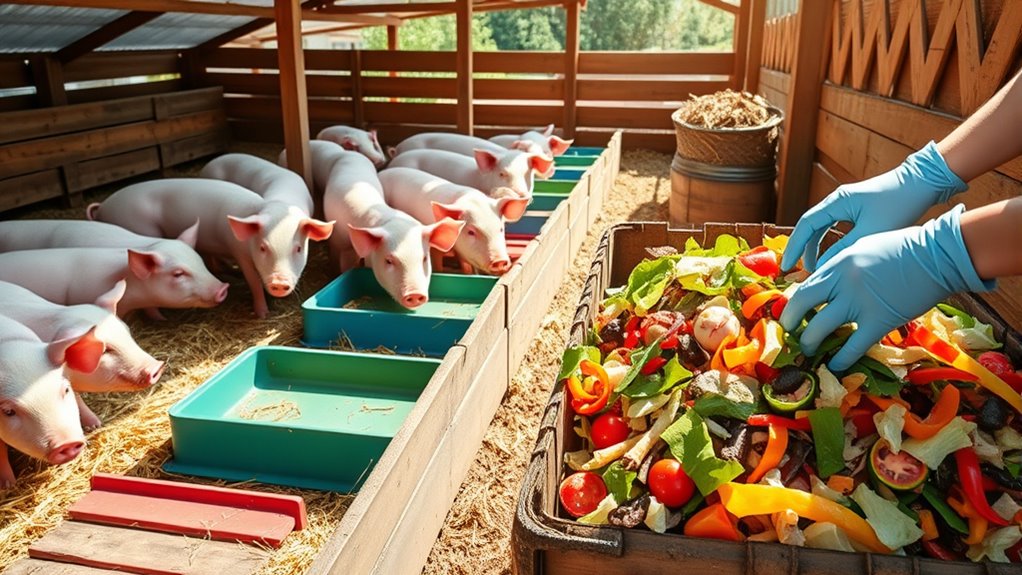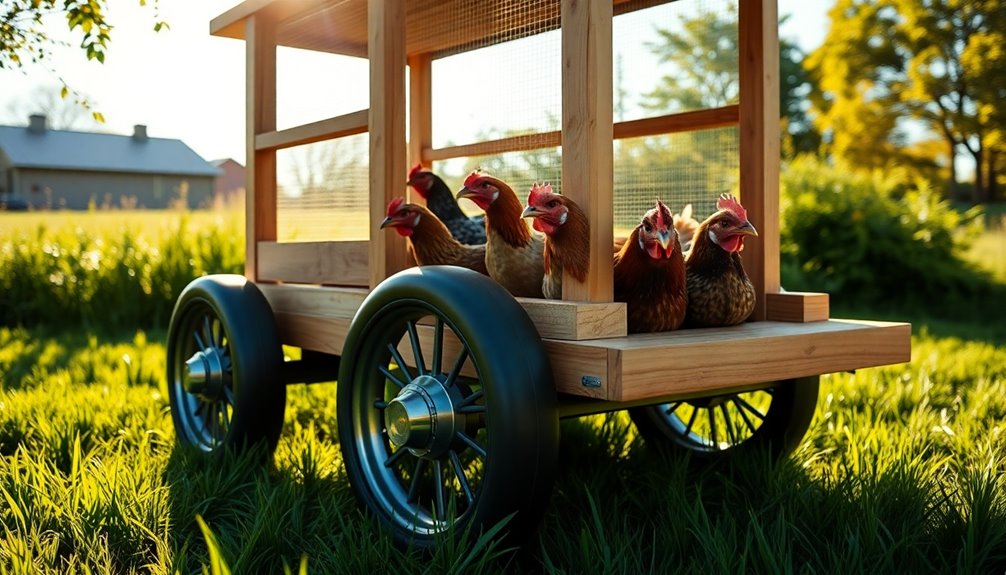To design an efficient pig pen, position feeders in accessible spots to prevent crowding, and choose durable, easy-to-clean feeders. Use bedding materials like straw, wood shavings, or rice hulls that are dry and comfortable, while managing waste with sloped floors and drainage to keep the environment clean. Regularly replace bedding and maintain hygiene to reduce disease risks. For more tips on creating a healthy, well-organized space, keep exploring strategies that promote pig well-being and cleanliness.
Key Takeaways
- Position feeders in accessible, designated zones to reduce spillage and prevent crowding.
- Use durable, easy-to-clean bedding like wood shavings or straw, and replace regularly for hygiene.
- Incorporate sloped floors or drainage systems to direct waste away from pigs and bedding areas.
- Design layout to facilitate waste removal, minimizing contamination and maintaining cleanliness.
- Maintain strict waste management practices with efficient collection and disposal to prevent odors and disease.

Designing an efficient pig pen is essential for maintaining a healthy and productive environment. When you focus on how pigs feed and rest, you create a space that encourages good health and minimizes waste problems. Understanding their feeding habits helps you plan the layout of feeding areas so that pigs can eat comfortably without causing unnecessary mess. Pigs are naturally curious and tend to root around when feeding, so providing designated feeding zones equipped with appropriate feeders can reduce spillage and contamination. You want to position these feeders in accessible locations that allow pigs to feed without crowding, which can lead to stress or injury. Using durable, easy-to-clean feeders also ensures that feed remains fresh and reduces waste, making feeding more efficient.
Bedding materials play a crucial role in pig pen design because they influence both hygiene and comfort. Selecting the right bedding can absorb moisture, control odor, and prevent bedding from becoming a breeding ground for bacteria or parasites. Common bedding options include straw, wood shavings, or rice hulls, each with its benefits. Straw, for example, provides excellent insulation and comfort, encouraging pigs to rest and root naturally. Wood shavings are lightweight and absorbent, making them easy to manage and replace regularly. Rice hulls are a sustainable choice, though they may require more frequent replenishment. Whatever bedding you choose, ensure it’s dry and clean to prevent skin infections and respiratory issues. Regularly replacing bedding and managing waste underneath helps keep the environment sanitary, which is vital for the pigs’ overall health. Incorporating proper waste disposal methods can further enhance sanitation and reduce odor issues. Additionally, maintaining a clean environment can help prevent the spread of disease and improve pig well-being.
In addition to these elements, you should plan your pen layout to facilitate easy waste removal. Position feeding areas and resting zones in a way that minimizes contamination from waste. Incorporate sloped floors or drainage systems that direct liquid waste away from pigs and bedding, simplifying cleaning routines. Using bedding materials that are easy to clean or replace can significantly reduce labor and improve waste management. Remember, a well-designed pig pen balances comfort, accessibility, and hygiene. When pigs have access to proper bedding and feeding setups, they’re less likely to develop health issues and more likely to stay active and productive. Ensuring that all waste is managed with appropriate waste management practices supports a cleaner environment and healthier pigs. Additionally, implementing efficient waste collection systems can help streamline daily cleaning routines and maintain cleanliness. By paying attention to their natural feeding habits and providing suitable bedding materials, you create a healthy environment that supports their growth and simplifies waste management tasks. This proactive approach helps you maintain a cleaner, more efficient pig-raising operation with fewer problems and better results.
Frequently Asked Questions
How Often Should Pig Pens Be Cleaned for Optimal Hygiene?
You should clean pig pens regularly to maintain ideal hygiene practices. Following a consistent cleaning schedule—at least once a day—helps prevent the buildup of waste and bacteria. If the pens get heavily soiled, more frequent cleanings are necessary. Proper hygiene practices not only keep your pigs healthier but also reduce odors and disease risks. Staying diligent with your cleaning routine ensures a clean, safe environment for your pigs and simplifies ongoing management.
What Materials Are Best for Durable Pig Pen Construction?
Did you know that choosing the right building materials can substantially extend your pig pen’s lifespan? You should consider durable options like galvanized steel or treated wood for construction, ensuring they withstand weather and pig activity. Fencing options such as welded wire or heavy-duty chain-link provide strength and security. By selecting high-quality building materials and fencing options, you create a safe, long-lasting environment that’s easier to maintain and keeps your pigs secure.
How Can Odor Be Minimized in Pig Waste Areas?
To minimize odor in pig waste areas, you should improve ventilation systems to increase airflow and reduce smell buildup. Regularly remove manure and clean the area to prevent odor accumulation. Using odor neutralizers can also help, as they chemically or biologically break down smelly compounds. Combining good ventilation with neutralizers creates a fresher environment, making it more comfortable for both pigs and workers.
Are There Eco-Friendly Waste Disposal Options for Pig Farms?
You can explore eco-friendly waste disposal options by using composting options to turn pig manure into valuable soil. Additionally, biodegradable waste bags help manage waste responsibly, reducing plastic pollution. These methods keep your farm environmentally friendly while efficiently handling waste. Incorporating composting and biodegradable bags not only minimizes your farm’s ecological footprint but also promotes sustainable practices that benefit the environment and your operation.
What Are the Safety Considerations When Designing Pig Pens?
When designing pig pens, you should prioritize hazard mitigation and structural safety to protect both pigs and workers. Guarantee the design minimizes injury risks, like sharp edges or unstable structures, and provides proper ventilation to prevent respiratory issues. Use durable, non-toxic materials, and secure fencing to prevent escapes. Regular inspections help identify potential hazards early. By addressing these safety considerations, you create a safer environment that promotes health and productivity.
Conclusion
Remember, a well-designed pig pen isn’t just about space—it’s about understanding how pigs naturally behave and manage waste. Some believe that pigs can self-regulate their environment if given proper conditions, which is partly true. By observing and adapting their space, you can promote healthier, cleaner conditions. Embrace the idea that thoughtful design and waste management aren’t just practical—they reflect a deeper respect for pigs’ natural instincts, leading to a more sustainable and humane farming approach.










